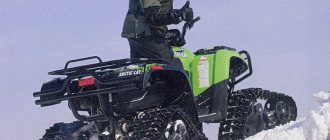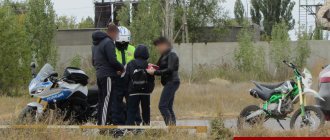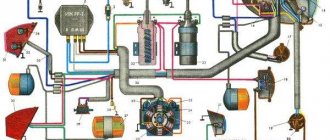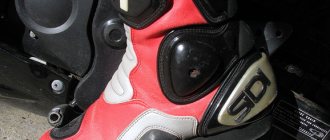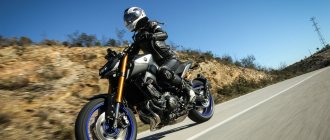Good day, dear readers! It’s winter outside, it’s snowing and the weather is changeable. Temperatures range from -30 to + 5. Snow sometimes gives way to weak nasty rain.
This is the most unpleasant time for a biker. After all, a motorcycle in winter is not very comfortable, and some people argue that it is completely impossible. Each side is right in its own way. Let's delve into this issue and draw a conclusion.
The collision of theory with life
So, it is traditionally not customary to ride an iron horse in the cold season. But riding a bicycle in winter is also not recommended. Regarding the latter, we can safely say that the popular opinion about winter skiing is completely wrong. In winter you can enjoy both cycling and e-biking.
When it comes to a motorcycle or moped, the situation changes. If a cyclist primarily moves along sidewalks or bike paths, then the motorcyclist is a full-fledged participant in the movement. The situation on the city's roads in winter is already tense enough to make it even worse. Such an environment is, without exaggeration, dangerous for a biker. The very weight of the motorcyclist here plays against his driver. Of course, competent work with weight allows you to often get out of difficult situations, but without experience this will be a big problem.
Also, the surrounding weather environment has a strong impact. It becomes noticeably cold even in late autumn, when the temperature does not yet exceed zero. In winter, moving around is also completely uncomfortable.
Road situation in winter
In winter and late autumn, public roads become completely unpleasant and unsuitable for driving without the protection of a car body. Even in summer, driving along them is far from a gift. Add to this the fountains of mud and reagent that flow from under the wheels of each car, and in which any participant in the movement will bathe, and you will get the real picture. In addition, do not forget about sleet and frost. Both the motorcyclist and the other driver can make a mistake. Only where the motorcyclist breaks his neck will the driver of a four-wheeled vehicle simply slide slightly into the next lane. Accordingly, if it does not hit other vehicles, then there will be no problems.
More pleasant situation on country roads. If the road is well-trodden, almost any motorcycle can easily pass along it. It's even nice. However, you still shouldn’t expect full movement.
Fans of motocross and other extreme disciplines have a much more pleasant picture. Those who use a motorcycle as a sports equipment, on the contrary, can get a lot of pleasure from riding on a snowy track! It is much more varied and requires more control over the motorcycle, and therefore much more interesting.
Accordingly, of all the options, the road situation allows you to use a motorcycle more or less comfortably only for sporting purposes and for quiet driving outside the city. It is very pleasant and interesting to ride in the snow. Driving on public roads in winter will be at least uncomfortable, and sometimes even dangerous.
Motorcycle control features
As we noted just above, in winter the behavior of the iron horse on the road changes. Areas with icy conditions, constant water under the wheels and severe pollution make driving difficult. Accordingly, if you decide to take such a trip within the city, you need to be as careful as possible, avoid high speeds and move only in the far right lane. You need to understand that the road can present a lot of unpleasant surprises, to which you need to have time to react correctly - ice, another driver’s mistake, rain and snow, or a wave of mud from a puddle of reagent. If you suddenly exceed the speed that is possible (even not permissible by the rules, but available for a given area), you can lose control. Any mistake and there is no turning back.
If there are no other participants in the movement, and you are driving in the snow, then you can experiment. Of course, it’s better to avoid falls and there’s no need to take unnecessary risks, but on packed snow the motorcycle is much more stable than on asphalt with a crust of ice.
It's important to remember one thing. There are no incredible metamorphoses in management. But winter skiing has its own specifics. And if testing it on a bicycle is not dangerous (or practically not dangerous for a cyclist), then some mistakes of a motorcyclist cannot be forgiven.
There is a misconception that a motorcycle cannot be driven in winter. There are jokes on social networks about square wheels and caps of snow. This is not true. 90% of the way, the biker will not even notice that he is riding on a winter road and may not even encounter any pitfalls. But if he hits them, he will remember it forever. These situations are very dangerous because... If a person suddenly decides to try winter skiing, then he goes out onto the road and starts moving very carefully. After some time, he realizes that there are no special obstacles and tries to continue driving in summer style, and this is where the accident occurs. If you decide to ride a motorcycle in winter, then be very careful from the beginning of the trip to the very end. No jokes or risks should be allowed. Hooliganism can only be done on the track or near a country house. But even here you can seriously clean up.
How to prepare your motorcycle and yourself for winter riding
No motorcyclist will say: “I don’t ride a motorcycle in winter,” giving only one reason. The reasons for the general winter “lethargy” are as follows:
- Low coefficient of wheel adhesion to the road leads to falls.
- Equipment – suffers from corrosion due to salt road reagents, losing its attractiveness.
- The need to ride in thick clothes hinders movement and robs comfort.
- Incorrectly selected equipment at low temperatures and frequent falls lead to injuries.
- The cold, bad weather, and the need to tinker a lot for a short trip are depressing.
Of course, the owners of a few sidecars, or cross-country bikes, are in a more advantageous position in winter than those who ride choppers or sports cars, but even they have to thoroughly prepare their equipment for winter use.
Everyone decides for himself whether winter is the right time to learn how to control a motorcycle again, whether he will be comfortable enough in winter on a scooter or motorcycle, whether it is worth bothering with “changing shoes” and buying winter motorcycle equipment, washing the bike after each “bathing” in caustic road reagents .
We insulate the engine
To ensure that the engine warms up faster and does not cool below operating temperature during a trip, motorists close the radiator from oncoming traffic. On motorcycles with liquid cooling, you need to do the same thing - install a hard shield in front of the radiator, or cover the air intake hole with a fabric “apron”. If you have an air vent, insulate the open intake manifold with soundproofing material and attach a shield in front of the cylinder that cuts the direct air flow. To make it easier to start the engine, install electric heating of the carburetor float chamber (based on heated handles), heating of the manifold and engine sump. Here you will have to “work with your head”, because there is no single “insulation standard” for motorcycles, and everyone “spins as best they can”.
Spark plugs, battery oil
Winter operation occurs at lower temperatures, so the spark plugs on a motorcycle (or scooter) need to be installed “hotter”, with a lower heat rating.
In cold weather, the battery quickly loses capacity. Every week (maximum two) it must be charged from the mains “all the way”. Before each trip, check the charge (if serviced, check the electrolyte level). In open or cold parking, it is generally recommended to remove it at night. In order not to leave the standard alarm system without power, replace it with a spare one (even an old one with a small capacity will do here).
Typical forum advice: as a means of easy starting - changing the oil in the engine (and also in the shock absorber) to a more liquid one - has many opponents. And they are right. The engine only needs oil fluidity for the first couple of minutes, and in normal operation it should create a reliable film. Better use preheating.
Getting the wheels ready
Properly selected tires will allow you to ride a motorcycle in winter as confidently as in summer. For most road motorcycles there is a universal winter Velcro that gives good grip on ice and snow. For the city, as an alternative, racing “rain” tires are suitable.
You can stud cross-country tires yourself - with dowels, as motorcyclists of the 90s rode in the era of shortages - only for driving on ice or off-road. In the city, on asphalt, especially dry, driving on spikes, even 2–3 mm high, will only bring disappointment: they slip, make a lot of noise, and with a sharp start, the spikes will fly out, “shooting” at those around you.
Installing additional wind protection
Riding a motorcycle in winter without a windshield is still a “pleasure,” especially during classic rain and snow. Install the widest possible windshield. Yes, for a while you will have to put up with a slightly increased frontal resistance, but this way - you definitely won’t freeze to the bone.
Install roll bars on your motorcycle - they will help protect it and you while you learn to ride on icy bumps or winter slush. By the way, you can mount homemade leg shields on them, or attach factory ones from another model. If your bike has standard leg shields, you won’t have to fight off mud icicles from your motorcycle boots.
It’s easier for scooter owners in this regard - their legs are covered during the trip, but they also have something to add to the lining: cross-protection of the handlebars - even perforated, it well cuts off the cooling flow of the gloves. There are also soft “L-shaped” textile covers for the handles - they look ridiculous, but they cope with warming your hands in any frost.
Installing heated grips and seats
A pit or cross-country “bench” left even for an hour outside a warm garage can freeze your “butt” to the point of unpleasant consequences. You can safely ride a motorcycle in winter only with periodic heating. On sale there are universal “mats” for car covers, with a cigarette lighter connector. They fit any motorcycle. Classic heated steering wheel grips will come in handy not only in winter. In late autumn or early spring, in the rain, this option will be a salvation.
Learning safe driving techniques
The most important thing to do before riding a motorcycle in winter is to learn how to operate the gas correctly. Reflexes acquired on clean asphalt become dangerous in icy conditions. Even if you have perfectly prepared your bike and insulated yourself like a pro, at first you will feel like a beginner “sitting on a slippery log,” so be mentally prepared for the fact that you will fall. Most likely - more than once.
Training should begin before the snow falls or the road becomes icy. Open and close the throttle smoothly, so that you always feel the “connection” between the throttle position and the speed of the motorcycle. Practice accelerating and decelerating so that you approach a certain “marker” without applying the brakes.
Let's warm ourselves up
This is exactly the case when snowmobile options “rule” in the “field” and in the city. Motorcycle equipment for snowbiking is warm, light, waterproof. Depending on the duration of the trip, the weather, the type of motorcycle and your own skills, you can combine urban, touring and cross-country elements of equipment, but you must do this according to the “cabbage” principle. The more layers, the more reliable. In winter, you need to assemble the components of a motorcycle outfit with an emphasis on better protection of the lower back, neck, knees - the most vulnerable parts of the body that resist the wind.
Trousers
It is recommended to take snowmobile or touring ones in winter, with a high waist, a wide leg that unfastens at the bottom, and a membrane or foil lining. The presence of built-in protection is not important: in order to actively ride a motorcycle in winter without freezing your legs, you will still have to wear knee pads over them (preferably articulated ones).
Motorcycle boots
In winter, shoes for riding need high, hard, loose shoes. In order not to interfere with normal blood circulation, it should be 0.5–1.0 sizes looser and worn on a thick sock. Cross-country and touring versions with wide toes and thick textured soles - when driving in snowy “porridge”, you need to supplement them with rain shoe covers (fasteners at the bottom of the legs come in handy here). If you intend to ride in your old motorcycle boots, put self-heating insoles in them - then you can ride for a long time, without stopping.
Jacket
Touring versions are good, but in winter it is not ventilation that is more important, but insulation, since there are few purely winter touring sets; it is easier to find a snowmobile jacket that fits under which to wear thermal underwear and a tortoiseshell. A mandatory nuance is that the jacket must be long, with a membrane lining and lining. Waterproofness in “snow rain” - in winter is realized due to the same raincoat thrown over the top, rain leggings and shoe covers on the feet.
Gloves
As a budget option, in winter it is convenient to use long leather gloves with a high cuff, a warm lining and an internal protector. The disadvantage of this choice is low mobility of the hand, poor sensitivity of the fingers, which does not allow one to clearly sense the position of the lever or dose the force. Gloves are a very “delicate” point, because even if you wear too tight ones, you can also freeze without additional insulation (heating the handles becomes ineffective). Elastic cross-country shoes - although they will warm up from the palm side - will not protect you from wind or rain when riding. In winter in the city, protecting your knuckles is a must, but don’t wear motorcycle gloves with metal protectors or unregulated inertial ventilation - this could result in your fingers getting frostbitten even in a short time.
Helmet
Riding a motorcycle around the city in winter means collecting not only dirt and sand. A rather caustic road agent flies into the motorcyclist’s face, which, in combination with abrasive chips, is detrimental to the visor. In winter, a helmet should not only be good, but have additional scratch resistance, a double heated visor and a breath deflector, or a good pinlock. Modular or integral helmet - at sub-zero temperatures it doesn’t matter which one, the main thing is a closed one. The exception is open endour, with a special double wide mask. A balaclava - no matter what manufacturer - but always with a long, windproof neck.
Preparing your motorcycle for a winter ride
Technically, the motorcycle will not be subject to any overload from winter use. On the contrary, it is relaxation for the engine. Especially if the cooling is air. The main problem in the city is the ubiquitous dirt, which spoils all equipment. But, as we found out earlier, it is better to try not to drive in the city. Therefore, nothing will interfere with the snow outside the city. The main thing is not to forget to dry the brakes. Also, shock absorbers will work worse. Yes, and it would be good to change the engine oil.
Problems are also expected with the battery, which may be completely discharged. The motorcycle will start noticeably worse. You need to start with a kick.
For use on dirt or snow, it is of course better to get studded tires. For motocross motorcycles, special aggressive tires with huge metal spikes are sold. In the city, it would also be better to install a city spike. But it's difficult to get. Studded tires are made for scooters (few and sparingly), but for motorcycles they are almost exclusive. For sports use, rubber exists, but for the city, rubber such as Velcro or city studs is fantastic (at least, at one time I could not find such rubber for myself).
Features of motorcycle behavior and handling
The behavior of a motorcycle in winter is logically predictable, but as always happens: theory and practice are very different things. You understand that sharp turns increase the risk of falling, but still, at the moment of maneuvering, you get a wheel stall, seemingly out of the blue! The road surface plays a major role. On loose snow, the behavior of the motorcycle is reminiscent of riding on sand, and in wet snow or ice it resembles riding in the rain. Let us remind you of the article “How to ride a motorcycle in the rain?” In both cases, the handling is disgusting! Any sudden maneuvering leads to the wheel falling off or getting buried.
Braking on winter roads should be careful and gradual. The gas supply must also be smooth. For this reason, high-speed motorcycles are the most dangerous to ride in winter. Lightweight and small-capacity models are in an advantageous position; scooter riders have a fun life in the city in winter.
If you are brave enough to drive in the city in winter, then be sure to increase the lateral intervals from the edge of the roadway and the distance between the traffic in front and behind. I’ll explain about the lateral interval below, but with the distance everything is simple - the braking distance increases in winter, sometimes many times! Therefore, if you manage to brake in time, there is no guarantee that the driver behind you will not exceed the stopping distance! There is a risk of becoming a bike buffer between cars. We discussed this in the article “Distance in Traffic and the Concept of “Bike Buffer”.
Equipment and clothing for winter motorcycle riding
As we discussed above, skiing in winter is dangerous. We must not forget that even if you are riding alone, and there are no other road users, then the motorcycle itself is at least three times your weight. You won't be able to catch it with your foot like a bicycle or stop it abruptly. Accordingly, if the fall is unsuccessful, then this is a fracture. Sometimes not alone. This is why it is extremely important to wear as much protection as possible. Neck protection, armor, helmet and knees. Also, don't forget about motorcycle boots. Only in this form of Viking can one guarantee relative safety. Now about comfort. Be sure to choose the right clothes. It should be warm, windproof and relatively light. It’s better not to hinder your movements. The most difficult thing will be with gloves. After all, thick winter gloves do not allow you to fully control a motorcycle. Ordinary insulated motorcycle gloves will freeze. Therefore, it is definitely worth installing heated grips. Under the helmet you need to wear a balaclava or a mask that covers your face.
Summarize
Riding a motorcycle in winter is difficult and sometimes dangerous. You need to drive on public roads very carefully and carefully. You shouldn’t even try to achieve the effect of summer movement. If you decide to take a winter trip around the city, do it carefully and in the right lane, and even be as visible as possible to other road users. After all, most drivers never expect to see a motorcyclist in winter! Of course, nothing is impossible, but excessive self-confidence is destructive. In addition, be sure to use all types of protection. You need to be able to feel your iron horse and remember that all its weight is a huge problem in case of uncertainty or if you fall.
If we talk about sport and fun riding in the suburbs, copses or motorcycle trails, there is a lot of freedom for creativity. If there is a lot of snow, then it is better to buy a snowmobile. It handles much more confidently on snowy roads. The motorcycle is more suitable for thaws and mud. You can learn new useful skating skills and tickle your nerves.
Riding in winter is quite possible and this is far from a myth. But using a motorcycle as a full-fledged means of transport is unlikely.
Rules for riding a scooter in winter
Clothing is the first thing to think about if you want to ride a scooter in winter. You need to dress not just warmly, but also resistant to the wind (insulated gloves, overalls, windproof jacket).
Minor accidents (such as hitting a curb while parking) may not cause any harm during the warmer months. In winter, the plastic becomes brittle and can crack or break off even from slight vibration of the scooter engine.
In the summer, many scooter drivers neglect safety and ride a moped without a helmet, but driving in winter requires greater attention to safety, since the snow makes the scooter more likely to skid. A helmet (best of all - a closed one) will protect your head not only from injury, but also from frost and cold wind.
Braking a scooter on a winter road follows completely different rules than in summer. When approaching an obstacle or stopping place, should you gradually slow down? Moreover, you need to brake using the engine, not the front brake disc. If you apply the front brake, the wheel will jam, the tires will begin to slide, and the scooter will stop much further than the intended place.
When starting to ride a scooter, you should be careful, do not squeeze the throttle fully, but turn it no more than a third, otherwise the wheel will begin to slip, the back of the scooter will be thrown to the side, and the driver will fly off his “iron horse”.
The maximum speed that can be reached in winter? 30 kilometers per hour. If you exceed the speed, the moped may become uncontrollable and simply fly off the road.
The hardest part about winter driving is the turns, which should be started early. Slow down in advance, and when turning, tilt the scooter slightly to the side, but make sure that the tires do not slip.
For example, when turning left, the speed is reduced to 10-15 km/h (the more snow - the lower the speed), and then the scooter tilts slightly to the left.
be careful
Do not forget that riding a scooter in winter is a very dangerous activity. The driver risks not only his own health, but also the health of others. Those who decide to drive in winter must be extremely careful, constantly monitor the situation and not allow themselves to be distracted. It is also worth remembering that even winter tires designed for driving in aggressive conditions will become hard, slippery and difficult to control.
Still, the best option is to store the scooter in the garage until spring.

